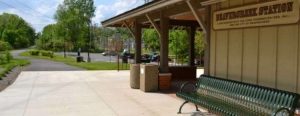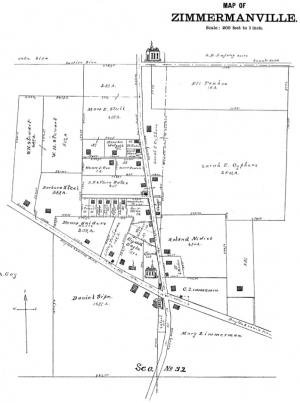Book
In the late 1800’s, John Schantz, who along with wife Mary bought the property in 1868, became frustrated when the mill dam, built of oak planks, broke one too many times. He abandoned the water wheel and converted the mill to steam power, channeling the excess into clumsy radiators in the house – they weren’t much to look at, but it became the first home in the area to have steam heat and shortly after, an indoor bathroom.
Near the house was a large barn; west of it stood the mill on the slope of the creek. Further west from the mill was a sawmill, and east of it was a frame building that was a smokehouse above and a springhouse below. The water is a cool 50°F and was used in the cooling of warm milk prior to use or shipment to the diaries. This building is known as the Solomon Shoup Springhouse and is the only springhouse known still to be standing in Beavercreek. Also nearby were a blacksmith shop and a carriage house.
https://beavercreekliving.com/book/itemlist/user/23-brettwilliford?start=140#sigProIdb75020b196
Head south and turn into the parking area of Beavercreek Station at the 9/11 Memorial. This basin was previously known as Shoup’s Station, on the Pennsylvania rail line. Just south of the tracks was the Dayton and Xenia Traction Company Line, which traversed farmlands east to Xenia and followed what is now Patterson Road into Dayton. On the east side of North Fairfield Road is an access road that crosses the Little Beaver Creek. This leads to the Schantz-Hagenbuch Home, originally a small one-room brick house which George Shoup built for his son Solomon in 1810.
George had brought his family from Frederick, Maryland in the very early 1800’s to continue his milling trade. He constructed a large three story, three stone undershot water wheel mill on the south side of the creek with a daily capacity of forty barrels. Over the years, both the Shoup and Hagenbuch families added numerous additions. An enormous fireplace had a handwrought crane that swung over the fire. The bricks were all fired on site, just west of the home.
 September 11, 2001 Memorial Dedication
September 11, 2001 Memorial Dedication
September 11, 2001 Memorial Dedication
September 11, 2001 Memorial Dedication
 John Schantz Home and Mill
John Schantz Home and Mill
John Schantz Home and Mill
John Schantz Home and Mill
 1874 Map of Zimmermansville
1874 Map of Zimmermansville
1874 Map of Zimmermansville
1874 Map of Zimmermansville
https://beavercreekliving.com/book/itemlist/user/23-brettwilliford?start=140#sigProIdb596fda103
Lifers still refer to this area as “Push On”, but no one knows the exact history of the name. Two stories seem to be most common, the first is that farmers driving cattle from Xenia to the Dayton slaughterhouses (On Springfield Street near the former ‘Stockyards Inn’) would rest the herd near the current intersection of Route 35 and North Fairfield Road before they would ‘Push On’ to Dayton. It is also told that train and traction (more on this shortly!) conductors would ask passengers if they were disembarking or if they would ‘Push On’ to Xenia - this is the most common story.
On the east side of the downhill grade is Meadowbridge Drive. Beaver-Vu bowling alley has been a long-time favorite of Beavercreek residents - especially in the 1970's when a billiard room was constructed. Original owner Cy Grilliot was an intimidating character who would stare down patrons at the desk until they mustered the courage to ask for his assistance. His saltiness may have come from customers enjoying too many libations and then rolling bowling balls down North Fairfield Road - names withheld to protect the accused!
Behind the bowling alley is a dental office complex that was for decades the Beaver-Vu skating rink, the first in the area that didn't offer hardwood flooring.
An Imperial Grocer and Goldman's Shopping Center were also nearby.
 Beaver Vu Interior
Beaver Vu Interior
Beaver Vu Interior
Beaver Vu Interior
 IGA Grocery
IGA Grocery
IGA Grocery
IGA Grocery
 New Businesses
New Businesses
New Businesses
New Businesses
 Dayton Stockyards
Dayton Stockyards
Dayton Stockyards
Dayton Stockyards
https://beavercreekliving.com/book/itemlist/user/23-brettwilliford?start=140#sigProId7c6db20251
The German Baptist church was prevalent in Zimmerman and throughout the township dating back to 1805, the original ministers being Jacob Miller, Elder Sigler and Moses Shoup. Once a year, their custom of ‘washing of feet’ would occur following communion. One of the ministers would wash the feet of the brethren (the men), while the sisters would wash the feet of the ladies. In slang, they were often referred to as ‘Dunkers’ or ‘Dunkards’ due to their tradition of full immersion during baptism, where members kneeled into the water and were dipped three times, face first.
German Baptists were opposed to war and would not bear arms, nor vote at political elections. Disputes were settled in the church without appealing to the laws of the country.
Also in Zimmerman were a blacksmith shop and the Stewart Grocery, which would provide on credit or by barter. During the Great Depression, Crawford Smith owned the store, then named Smith Grocery, he offered credit to accommodate customer’s needs regardless of ability to pay at that time.
The area most now consider the center of Beavercreek was long ago known as the settlement of Cimmermanville, then Zimmermanville, and later shortened to Zimmerman. The first home built here was at the southeast corner of Dayton-Xenia and North Fairfield Roads for Jacob Zimmerman, for whom the village was named. In this home was the first grocery. He also kept a house for ‘the entertainment of travelers.’
This was the second-largest town in the township to Alpha. Zimmerman School #12 sat just west of the intersection and was led by Professor Frank Zimmerman in the early days. This was a rare two-room school with the older students in the Big Room and the younger in the Little Room. Well behaved students would be awarded the honor of ringing the school bell for recess, while those not-so-fortunate would lug coal and clean the ash pan.
 North Fairfield Road
North Fairfield Road
North Fairfield Road
North Fairfield Road
 Late 60's or early 70's
Late 60's or early 70's
Late 60's or early 70's
Late 60's or early 70's
 Zimmerman School
Zimmerman School
Zimmerman School
Zimmerman School
 Zimmerman in 1874
Zimmerman in 1874
Zimmerman in 1874
Zimmerman in 1874
https://beavercreekliving.com/book/itemlist/user/23-brettwilliford?start=140#sigProIdc46f289e27
Continue east toward North Fairfield Road. The barn at Deal’s Landscaping was built in the 1850’s by the Miller family on Hanes Road, disassembled, and moved to this location in 1988.
Ahead on the right was the Hail & Hearty restaurant, which started as a Hasty Tasty, Char-Burger, The Shamrock, then Mama Bear's, and later Debra Lee’s, Naomi's, Grandpa's Cafe and most recently Woody’s Barbeque. The building was demolished in 2016 to make way for an automotive repair shop and strip center.
Does anyone remember a restaurant named The Omen?
https://beavercreekliving.com/book/itemlist/user/23-brettwilliford?start=140#sigProId22e2db6e90
Just ahead on the left, you’ll find Marsetta Drive. From the mid-1850’s to mid-1870’s, this area was known as ‘Pants Down Woods’. Matilda Stanley was born in Reading, Berkshire, England in 1821 and later married Levi Stanley, son of Richard “Owen” Stanley, king of a prominent gypsy tribe. Owen and his affiliated families settled in north Dayton in 1856. Upon Owen’s death, Levi and Matilda became king and queen, attracting many gypsies to the Miami Valley.
These nomads would often commit highway robbery along this stretch of the Dayton and Xenia Turnpike. Their tactic would be to steal a man’s wallet and pants so that he couldn’t report the matter to the authorities until after dark, facilitating their get-away. Hence the name “Pants Down Woods”. Matilda died in 1878 and is interred in Dayton’s Woodland Cemetery. The crowd at the ceremony was estimated to be 25,000 with a procession of a thousand carriages from downtown to the cemetery!
You can download her obituary from multiple newspapers below...
 Levi Stanley Burial Marker
Levi Stanley Burial Marker
Levi Stanley Burial Marker
Levi Stanley Burial Marker
 Matilda Stanley Monument
Matilda Stanley Monument
Matilda Stanley Monument
Matilda Stanley Monument
https://beavercreekliving.com/book/itemlist/user/23-brettwilliford?start=140#sigProIdaa90fb9b88
On May 26, 2014, the city of Beavercreek hosted it's annual Memorial Day Event at Veteran's Memorial Park. The event kicked off with the St. Andrew Pipes and Drums rendition of Amazing Grace, followed by a welcome and opening remarks by Mayor Brian Jarvis and the Invocation by Pastor Paul Craig.
The American Legion Post 763 posted the Colors and VFW Post 8312 raised the Flags over the event followed by the Boy Scouts leading the audience in the Pledge of Allegiance.
Adjacent to the fire station is the Harshman-Zimmerman Cemetery, burials include one of the area’s first doctors, Dr. George Zimmerman, as well as several members of the Harshman family. Further east at 3685 Dayton-Xenia Road is a farm of nearly 49 acres that has been in the Durnbaugh family for in excess of 140 years! Near 3600 Dayton-Xenia Road was the location of the Rest Haven, built in 1924, famous for their live black bears!
Enjoy this diagnosis and treatment attributed to Dr. Zimmerman on March 26, 1801: "...your mother's illness is a catarrh or rhumatic fever and is caused by the stomach and is a stomach cough, although the Zelnkoder may come from the lungs, such as a sickness is not half as dangerous with old people as with younger ones. I wish wither her medicine your mother would take what I now tell you.
Take ½ gallon hard vinegar, 1 handful yssop, 1 handful fluellin, ½ oz. sea onion, 1 oz. gum amoniac boil it down to half then strain and take the same amount of honey and boil down to 1 pint. She should take 3 times a day, 1 Tbs. in a teacul of milkshotten...
There is another cure for such a sickness. Take a fresh laid egg, boil it in the urine of the patient, then 10-15 small holes in the egg, bury it in an anthill and whn the ants have eaten up the egg, the patient will be well."
 Durnbaugh Engagement
Durnbaugh Engagement
Durnbaugh Engagement
Durnbaugh Engagement
 Rest Haven Bears
Rest Haven Bears
Rest Haven Bears
Rest Haven Bears
 Rest Haven Sold
Rest Haven Sold
Rest Haven Sold
Rest Haven Sold
https://beavercreekliving.com/book/itemlist/user/23-brettwilliford?start=140#sigProId38d9966473
Continue east on Dayton-Xenia road beyond Grange Hall Road. 2611 Mardon Drive was the home of the Family Room restaurant, which opened in July of 1961. At 3930 Dayton-Xenia Road, you’ll find the Daniel C. Coy house, built c.1896. Daniel was a prominent local farmer and was also a practicing chiropractor in Dayton.
As you approach the stoplight at N. Longview Drive, the neighborhood we call Knollwood was once a town of its own including a grocery, post office and other necessary services over the years including:
- The Knollwood Barber Shop
- The Knollwood Carry-Out
- The Knollwood Hobby Shop
- The original Lofino's at D-X and Brook Lynn
- The Library next to Lofino's
- Cassano's Pizza King
- Shoup's Sporting Goods
- Kozen's Hardware
- Tom's Sohio
- Karl's Marathon
- The Shell Station with Dallas Lunsford's Chevelle, 'Snoopy' and his other drag car, 'Red Baron'
- Fry's Auto Parts and more!
There were plenty of oil pan scrapes on North Central from cars jumping the hump in the road - not to mention the infamous cinnamon oil dipped toothpicks from the corner pharmacy that were ultimately banned by Principal Sweet at Ferguson Junior High! Horses were a common sight in the area then as well...
Its most rapid development came as there was a shortage of housing for returning WWII veterans. There is a wide variety of bungalow style homes as well as pre-fabricated homes manufactured by Sears-Roebuck and the Lustron Company. This is also the location of the Beavercreek Senior Center, affectionately known as the Old Lofino’s (even though it was the second Lofino’s!), a locally owned grocery. Hawker Church experienced tremendous growth and built a new structure just to the north of the Senior Center.
-gallery-19WKnollwood-/gallery-
Navigation
Latest Blog Posts
- Just Don't Call Us Late For Dinner...
- Remember When...
- What A Long, Strange Trip It's Been...
- Snow Down = Slow Down
- School Bus Safety - Just Do It!
- Stevenson Road Covered Bridge
- Our Road Crews Are Worth Their Salt!
- The Most Colorful Of Seasons!
- Popcorn Fest! - Then And Now
- Pre-School Paradise!
- Remembering Riffles
- Ten Year Anniversary Of The Beaver Statues














